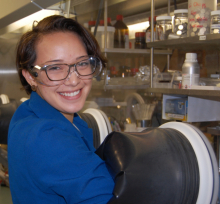
Major:
Mentor(s):
Faculty Sponsor(s):
Faculty Sponsor's Department(s):
Project Title:
Project Description:
Next-generation battery technologies for energy storage are crucial in order to become fully independent from fossil fuels because renewable energies such as solar and wind are intermittent. There are many alternatives to current commercialized lithium-ion batteries that alter the chemistries and engineering of cathodes, electrolytes, and anodes. One of the most promising systems for next-generation energy storage is Lithium–Sulfur (Li–S) batteries. The main two advantages of Li–S are (i) the high theoretical capacity of elemental sulfur and (ii) the sustainability of sulfur-based materials over toxic, expensive heavy metals such as cobalt. Sulfur can theoretically achieve 1675 mAh g–1, but due to the parasitic polysulfide shuttle problem that occurs when sulfur in the electrode dissolves in the electrolyte, the capacity rapidly fades. We present an optimization of the previously studied sulfur-based material that has a theoretical capacity of 609 mAh g–1 and 98% capacity retention over 200 cycles. In comparison to current LiCoO2 battery technology, this material has a theoretical capacity approximately three times greater.
